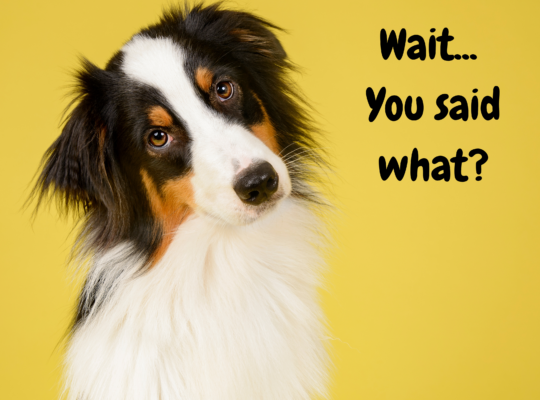After a long day away from home, I sat down to answer emails and respond to text messages, entirely absorbed in my phone’s screen. Suddenly, I felt a warm nudge on my hand as Oreo, my two-year-old pup, pressed his snout against my arm, pushing my phone away. His eyes met mine, as if to say, “Hey, I’m here too!” The moment was clever, cute, and frustrating all at once. Leaning into my behavioral knowledge, I resisted the urge to respond immediately, trying not to reward this interruptive behavior. I finished my email and, after what I deemed a sufficient length of time since Oreo’s nudge, gave him my attention for some greatly appreciated belly rubs.
This interaction left me with a flood of thoughts about attention: our very real need for it, how we express that need, and the challenges we face in giving it fully in our increasingly busy, distraction-filled world. Ultimately, attention is a choice.
From my perspective, time is our most precious resource, and how we budget it significantly impacts our well-being and the well-being of those around us. The truth is, none of us knows how much time we have in our “account,” and it’s easy to spend it on things that don’t really matter. If I had paused during my interaction with Oreo and asked myself whether my attention was focused on what mattered most, my honest answer would have been “no.” Yikes!
Taking a mindful pause in that moment would have helped me prioritize what truly matters. It would have allowed me to reframe what I labeled as “attention-seeking” as an invitation to reconnect after a long day apart. I could have made an intentional choice to strengthen my bond with Oreo, rather than stewing in frustration over an uncompleted task or what I perceived as poor behavior.
Mindful Reflection – Have you found your attention pulled in multiple directions? As you reflect, what might you have gained by pausing to make a more intentional choice?
Our lives are a juggling act. We constantly balance our “have-tos” and our “get-tos” on our to-do lists. Mindful pauses can help us notice when these are sliding out of balance, as was the case for me with Oreo. This doesn’t mean we should only focus on what we enjoy. Choosing to tackle the less pleasant tasks like filing taxes, paying bills or cleaning the house ensures we’re able to give undivided attention to the people and animals we love when we are with them..
All beings need connection. For humans, this is especially evident in childhood. British psychiatrist John Bowlby’s attachment theory demonstrates how secure relationships with caregivers help children grow into socially capable adults. Beyond providing survival and security, these bonds foster resilience. During developmental years, when children are learning to process and respond to fear or uncertainty, a caregiver’s ability to offer understanding and emotional connection is critical. If a caregiver fails to do so, the child may grow to feel misunderstood and anxious.
Building on Bowlby’s work, Mary Ainsworth developed the Strange Situation Procedure to identify attachment styles in children. In her studies, infants were briefly separated from their caregivers and then reunited. Their responses led to the identification of three main attachment styles:
- Secure: Confidence in exploring the environment, distress at separation, and quick comfort upon reunion.
- Anxious-Avoidant (Insecure): Avoidance of seeking comfort or connection.
- Anxious-Ambivalent/Resistant (Insecure): Clinging behavior and difficulty being soothed.
Later, Mary Main classified a fourth style, Disorganized/Disoriented Attachment, which is strongly associated with clinical behavioral and mental health challenges.
Parallels in Dogs
Ethologists and canine behaviorists have adapted the Strange Situation Procedure to observe dogs’ attachment behaviors. Researchers József Topál, Ádám Miklósi, Vilmos Csányi, and Antal Dóka found that securely attached dogs explore new environments with confidence, periodically checking in with their owners for reassurance. These dogs may experience mild distress when separated but recover quickly upon reunion.
In contrast, dogs lacking consistent attention or experiencing neglect may exhibit behaviors resembling insecure attachment, such as excessive clinginess, anxiety, or avoidance. These attachment issues can also affect dog-to-dog interactions. For example, research shows that dogs with secure attachments are more likely to engage in healthy, reciprocal play, while those with insecure attachments may display overly submissive or aggressive tendencies.
By providing the focused, responsive attention our pets need, we not only support their emotional well-being but also strengthen the special bond we share with them.
Mindful Reflection – How does it feel to be on the receiving end of inattention?
Being on the receiving end of inattention isn’t unusual. Classic sitcoms like Leave It to Beaver often poked fun at situations where children vied for their parents’ attention, only to be dismissed as the adults were distracted by work or other concerns.
This experience isn’t limited to the parent-child or pet-owner dynamic. The next time you’re at a restaurant, look around. Notice how many distractions compete for attention: televisions on the walls, music overhead, cell phones on the table (or in diners’ hands), and even electronic menus. As you make your observations, consider how often people are missing the opportunity to strengthen their connections with those right in front of them.
In this sea of distractions, being intentional about our focus becomes crucial. By creating space for undivided attention, we foster deeper connections and build stronger bonds with those who matter most.
The parallels between human and canine attachment show just how much the quality of attention we receive affects us. Consistent, engaged interaction fosters a sense of security and strengthens our relationships. Mindful presence, whether it’s comforting a child, playing with your dog, or having an uninterrupted conversation with a friend, benefits everyone involved.
If you’d like to develop a plan for incorporating mindful pauses and making more intentional choices, reach out to me at sue.murphy@wavelengthwellbeing.com to see if my services are a good fit for you.
Wishing you a holiday season filled with opportunities to deepen your connections, both human and canine.







